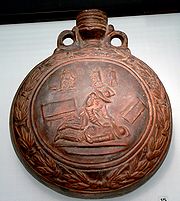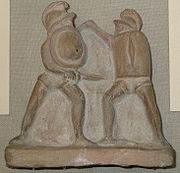
Thraex
Encyclopedia


Gladiator
A gladiator was an armed combatant who entertained audiences in the Roman Republic and Roman Empire in violent confrontations with other gladiators, wild animals, and condemned criminals. Some gladiators were volunteers who risked their legal and social standing and their lives by appearing in the...
, armed in the Thracian style with small rectangular shield called a parmula
Parma (shield)
Parma or parmula was a type of round shield used by the Roman army, especially during the later period of Imperial history.-Characteristics:...
(about 60 x 65 cm) and a very short sword with a slightly curved blade called a sica
Sica
The sica was a short sword or large dagger of ancient Thracians/Dacians peoples, used in Ancient Rome too. It was originally depicted as a curved sword, with a blade about 16-18 inches long and many examples have been found in what are today Romania, Bosnia, Bulgaria and Serbia, as well as...
(like a small version of the Dacian falx
Falx
Falx is a Latin word originally meaning sickle, but was later used to mean any of a number of tools that had a curved blade that was sharp on the inside edge such as a scythe...
), intended to maim an opponent's unarmoured back. His other armour included armoured greave
Greave
A greave is a piece of armour that protects the leg.-Description:...
s (necessitated by the smallness of the shield), a protector for his sword arm and shoulder, a protective belt above a loin cloth, and a helmet with a side plume, visor and high crest.
He and the hoplomachus
Hoplomachus
A Hoplomachus was a type of gladiator in ancient Rome, armed to resemble a Greek hoplite...
, with his Greek equipment, were usually pitted against the murmillo
Murmillo
The murmillo was a type of gladiator during the Roman Imperial age. The murmillo-class gladiator was adopted in the early Imperial period to replace the earlier Gallus, named after the warriors of Gaul...
, armed like a legionary
Roman legion
A Roman legion normally indicates the basic ancient Roman army unit recruited specifically from Roman citizens. The organization of legions varied greatly over time but they were typically composed of perhaps 5,000 soldiers, divided into maniples and later into "cohorts"...
, mimicking the opposition between Roman soldiers and their various enemies.

